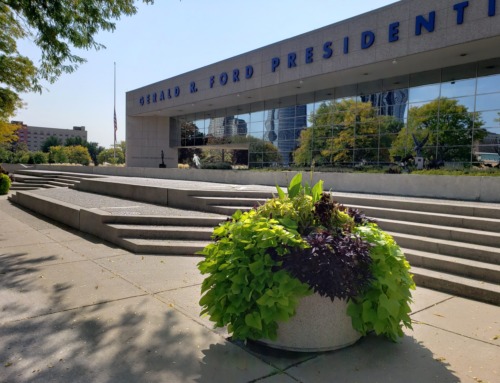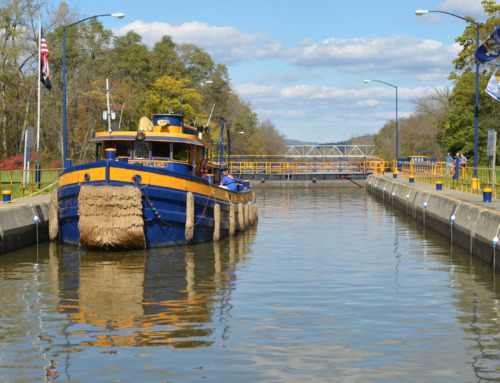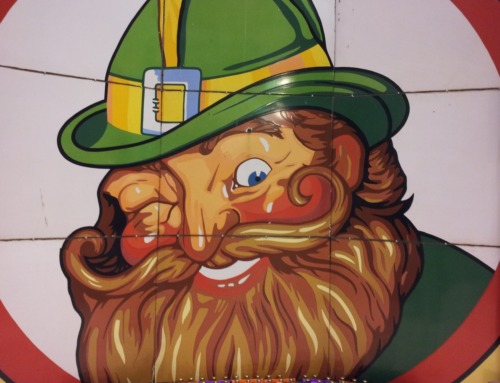It’s spring, and that means getting out and playing sports. While looking around at all the active ball fields, I can’t help but think of the classic line, “There’s no crying in baseball.” Many people know the quote. It comes from the timeless 1992 movie, A League of Their Own and tells the story of the All-American Girl’s Professional Baseball League (AAGPBL). Movie aficionados may know that four of the teams in the league were the Racine Belles, Kenosha Comets, South Bend Blue Sox and the focal team, the Rockford Peaches. What many people may not know, however, is that Michigan was home to not one, but four different teams in the AAGPBL throughout the years, and all were quite successful.
The AAGPBL was founded in the 1940s. When the United States entered World War II, many of the major league baseball players joined the armed forces. With so many of the men leaving, major league baseball executives brainstormed a way to keep baseball in the public eye. They came up with an idea to form women’s teams. The founders of the league included Philip K. Wrigley, Branch Rickey, and Paul V. Harper. The initial tryouts were held at Wrigley Field in Chicago. Over 200 women from across the country were invited by scouts to try out. League play officially began on May 30, 1943.
The first Michigan team to join the league was the Grand Rapids Chicks, added in 1945. That year, the league made significant changes administratively. It had started as a nonprofit and solicited contributions from businesses in team cities, but the cities had no control over the league. In 1945, AAGPBL began franchising the teams and the cities became participants in the administration of the league. The former Milwaukee Chicks moved to Grand Rapids with half of the players from the 1944 team returning to Grand Rapids under this new management.
The Chicks were warmly received by the city and the stands were soon filled with fans and inspiring news coverage in the local paper, the Grand Rapids Herald. Their first season was a winning one as the Chicks went 60-50 and made the playoffs. The next year, they did even better with a record of 71-41, again making the playoffs. In their third year, 1947, they had a worse record than the previous season at 65-47, but they peaked at the right time and won the league playoff championship. Through the rest of the seasons, the Chicks always made the playoffs, and won again in 1953.
Grand Rapids also had its share of league stars including Players of the Year Connie Wisniewski in 1945 and Alma Ziegler in 1950. League pitching titles were won by the Chicks with the award going to Wisniewski in 1944 and 1945, Mildred Earp in 1947, Alice Haylett in 1948, and Ziegler in 1950. In addition to these awards, several Chicks made All-Star teams from 1946 to 1954 including Wisniewski, Ziegler, Earp, Haylett, Ruth Lessing, Merle Keagle, Doris Satterfield, Earlene Risinger, Eleanor Moore, and Joyce Ricketts.
The Chicks played their home games at South High School in Grand Rapids, with the exception of 1950-1952 when games were played at Bigelow Field in Wyoming Township. After a fire destroyed Bigelow Field, the Chicks returned to South High School through 1954. The final year of the league, the Chicks had one of their worst seasons and went 46-45, but in spite of that, the team is considered to be one of the most successful franchises of the circuit.
Muskegon was the next city to host a team. The Muskegon Lassies were one of the expansion teams in the 1946 season, and played their home games at Marsh Field which still stands as a historic Park and hosts ball games.
The 1946 Muskegon Lassies posted a 46–66 record in their first year, and only placed sixth in the 8-team league. They improved to 69–43 in 1947, and won a close pennant race over the Grand Rapids Chicks. Muskegon was led by Doris Sams, who ranked in several offensive categories and also collected 11 victories, including a perfect game, which helped her earn the Most Valuable Player Award. Also, the team had three of the top four pitchers in Earned Run Average (Sams, Amy Irene Applegren and Nancy Warren), but lost to the Racine Belles in the best-of-five, first-round matchup 3–1. The 1948 season had Muskegon with a 66–57 record, gaining them a playoff berth, but again they lost to the Fort Wayne Daisies in the first round in three games.
The Muskegon team had a bad year in 1949 with a 46–66 record, but was able to reach the playoffs for the third consecutive year. Muskegon beat the Kenosha Comets in the first round, 3–1, but were swept by the South Bend Blue Sox in the semifinals, 3–0. In the 1950 season the Lassies registered the worst record in the league at 36–73, after relocating in the middle of the season to Kalamazoo when Muskegon could no longer afford them. The team was renamed the Kalamazoo Lassies, the third Michigan team in the AAPGBL.
Unfortunately, the league was steadily declining during 1949 and 1950 for a variety of reasons, the largest one being because men’s baseball was back. This led to another administrative reorganization. The cities became the owners of the teams in the 1950 season, and were now responsible to pay for advertising. It wasn’t long before the league began to see the cities struggling to pay the players. This was among the reasons veteran players began to leave. To make matters worse, there were also disagreements with the administration. Some of the players stayed purely out of loyalty and love of the game. Players for the Kalamazoo Lassies were among them.
Kalamazoo was granted the Lassies on a trial basis, and home games were initially played at Lindstrom Field. Later games were played at the Catholic Athletic Association Field, now known as the Soisson-Rapacz field. The new Kalamazoo Lassies played their first game, still in their Muskegon uniforms, on June 15, 1950. About 1,400 fans attended the game, which was won by the defending league champion Rockford Peaches, 8–2. The new Lassies won their first victory the next night, a 10–2 rout of Rockford led by pitcher Doris Sams and player-manager Bonnie Baker. The Lassies finished the season with a 36–73 record at the bottom of the standings.
The 1951 season was worse with a 33–75 record, but they managed to move up one spot in the final standings. In 1952, the team finished fifth of six teams with a 49–60 record, their best yet. Kalamazoo improved in 1953, ending third at 59–50–2(ties) and finally reaching the playoffs. After dropping the series opener to the first-place Fort Wayne Daisies, Kalamazoo won the next two games, advancing in the playoffs. The Lassies lost both games in the finals to the Grand Rapids Chicks.
In the 1954 season, the Lassies posted a 48–49–1 record and finished fourth of five teams, earning the right to go to the playoffs. In the first round, the team beat the South Bend Blue Sox in three games and faced the Fort Wayne Daisies for the championship title. In what would be the last series in the AAGPBL, the Lassies won 3 out of 5 games to give Kalamazoo the last victory in the league’s history.
One of the final three cities to join the league was Battle Creek in 1951. That year once again saw a reorganization. League officials were forced to cut the budget wherever possible and the paid administrators were dropped. A commissioner was appointed as the only paid administrator and players were told salaries would be adjusted as needed to keep the league running. In the 1951 season, the Belles from Racine, Wisconsin moved to Battle Creek. The new team would play their home games at Bailey Park, a fairly special park for many Michigan high school baseball and softball teams, as that is where the state championships are held.
The Belles were never successful in terms of records after the move to Battle Ceek. Their first season found them at 30-80. The next year, they posted a 43–67 record and finished in last place. The club then moved to Muskegon for the 1953 season and was renamed the Muskegon Belles.
The Muskegon Belles only played in 1953, with their home games played again at Marsh Field. Muskegon was the only city in AAGPBL history to host multiple teams. The move did not make the new Belles team any more successful. The team finished with a dismal 39–70 record and folded after the end of the season, leaving the AAGPBL with just five teams for its final season in 1954.
The sights, smells and excitement of being in a ballpark, especially in the spring, is always special to me. Even though there is no longer a professional women’s baseball league, we can all still get outside and enjoy a great baseball or softball team whether pro, semi pro or just a local youth game. What team will you be watching?







Leave A Comment
You must be logged in to post a comment.